Risk-Based Work Selection – Key to Optimized Turnaround Workscopes
Operations and Maintenance Practices in refineries focus on maximizing safety, reliability and profitability, in a highly competitive industry, with tight margins. A key consideration is to effectively manage annual maintenance costs which can be as high as 40-50 MM$/year for a medium size refinery. These costs can escalate to several hundred million dollars, if unplanned shut downs occur, resulting in loss of production.
Risk-based work selection (RBWS) is used to plan, schedule and execute maintenance work and is an industry Best Practice for improved reliability. The result is a risk-justified, optimized work list which uses maintenance resources cost effectively while mitigating unacceptable business and S/H/E risks. For TAs which require 200,000 to 1,000,000 person-hrs, the process has identified potential savings of 15-30% on estimated direct costs for the planned work scope.
RBWS is used for task prioritization for turnaround (TA) work scopes and routine maintenance work. Rigorous use of RBWS enables effective use of maintenance resources for risk reduction where it is truly needed, thus eliminating “discretionary” work which is not justifiable. The application of RBWS for Process Units enables refiners to analyze the probability, and consequence of an equipment failure. The analysis results are used to determine the work needed to prevent such failures in a cost effective manner. RBWS is a bundled process which uses Cross-Functional-Teams who are actively engaged in making risk-based decisions for their Units.
The process is supported by computer software which documents this work process in a consistent manner. The software should allow easy access to the work list data, development of failure scenarios and document the decision making process. These features ensure structured and efficient decision making. The software should include a risk calculator for the cross-functional team to estimate business and Safety, Health and Environmental (S/H/E) risk levels. For example, the simple risk calculator and embedded in Becht’s RBWS software, STRAITS©, combine the probability and consequence categories and plots the calculated unmitigated and mitigated risk levels on the risk matrix. S/H/E and economic risk are reported independently.
The benefit to cost ratio (BCR) is the benefit of mitigation (reduction in business risk) divided by the cost of the task. The cross-functional team uses the BCR along with other considerations (unmitigated S/H/E risk, cost of action item, bad actor resolution, etc.) to make the determination whether the task is in-scope based on previously developed task acceptance criteria. The figure shows the work list tasks in the order of decreasing BCR and illustrates the diminishing return nature of risk mitigation. This type of output from the RBWS work process allows plant managers to conserve maintenance resources and minimize risk by targeting the high risk reduction work list items corresponding to the left side of the figure.
On a major Turnaround, RBWS is a very effective methodology to eliminate work where it is not justifiable, and to add work, which has significant benefits to achieve run lengths between TAs without experiencing unplanned outages. Optimizing the work scope on a TA can achieve dual benefits of improved safety and reliability and longer run lengths, with reduced TA costs.
The importance of RBWS has grown significantly, with the trend towards longer run lengths on major Process Units in refineries. Additionally, the current industry practices require more decoupling of Process Units and more frequent TAs, which in turn put pressures on refinery Operating Budgets. RBWS is recognized as an Industry Best Practice to manage Operations and Maintenance Costs in a competitive manner.”

[readon2 url=”index.php?option=com_rsform&view=rsform&formId=8&Itemid=558″]Click to Request Software[/readon2]


